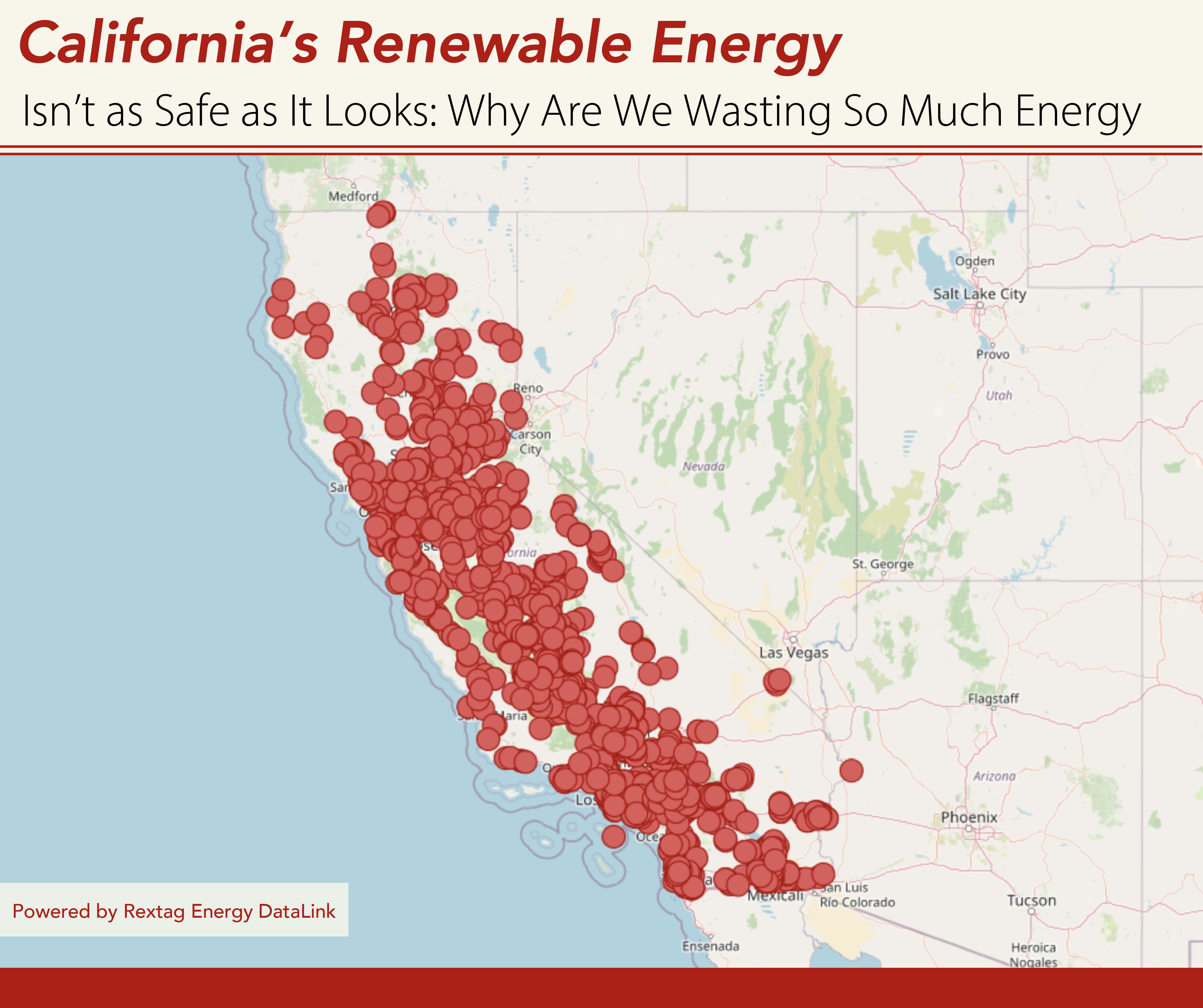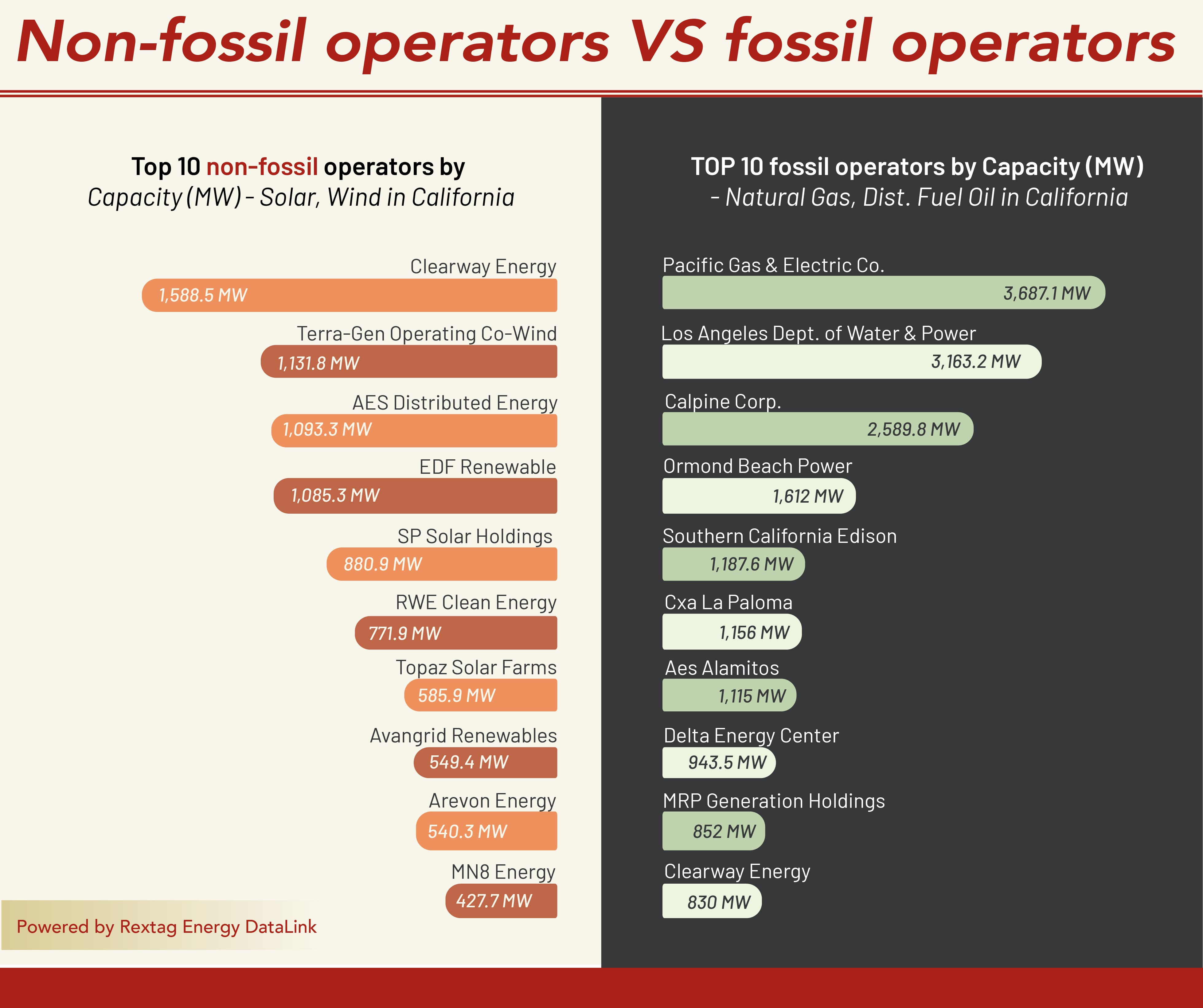Comprehensive Energy Data Intelligence
Information About Energy Companies, Their Assets, Market Deals, Industry Documents and More...
California’s Renewable Energy Isn’t as Safe as It Looks: Why Are We Wasting So Much Energy?
10/09/2024
- Power Plants: 307762 MW
- Solar: 140330 MW
- Wind: 8947 MW
- Hydrogen Plants: 2240 MMcf/d
- Geothermal: 2603 Geothermal Sites
- Carbon Capture Storage: Max Capacity 1.72 million tonnes per annum (MTPA)
California has long been at the forefront of renewable energy in the United States, from its vast solar farms to its growing battery storage capacities. But beneath the headlines of a "clean energy revolution" lies a complex reality—one shaped by ambitious targets, grid challenges, and the everyday experiences of Californians grappling with rising energy costs and increasing grid instability. As California pushes towards its 100% clean energy goal, the road is full of both promise and pitfalls.
Solar Power: A Shining Star with a Cloudy Side
FACT: CALIFORNIA PRODUCES ENOUGH SOLAR ENERGY TO POWER NEARLY 14 MILLION HOMES—YET MUCH OF IT GOES TO WASTE.
California Solar Power in Numbers:
- 27% of state electricity generation comes from solar.
- Enough solar capacity to power 13.9 million homes.
- 2.6 million megawatt-hours of solar energy wasted in 2024 due to curtailment (more than enough to power all of San Francisco for a year).
California leads the nation in solar power, with 27% of its electricity now coming from solar, more than any other state. By 2024, the state had installed a total of 46,874 megawatts (MW) of solar capacity, making it the top solar producer in the U.S. But despite these impressive numbers, the state is facing an unexpected problem: it’s producing more solar power than it can use at certain times of the day, especially during sunny spring afternoons when demand is low.
Challenges and Dilemmas
While solar power remains California’s flagship renewable energy source, the state is facing a growing issue of overproduction during midday hours when solar energy generation peaks but demand is relatively low. In 2024 alone, California wasted over 2.6 million megawatt-hours of renewable energy. This overproduction forces grid operators to curtail excess solar energy because there simply isn’t enough storage capacity to capture and use this power later when demand rises, such as in the evenings when people return home and energy usage spikes.
The infamous “duck curve” is a representation of this dilemma. The curve illustrates the mismatch between solar energy production and demand. The steep rise in demand when the sun sets forces California to rely on natural gas plants to meet the evening surge in energy needs, defeating the goal of achieving a fully renewable energy grid. This imbalance creates a critical challenge for the state’s utilities and policymakers.
Another pressing issue is grid congestion. Much of California’s solar generation occurs in rural, sunny regions far from the densely populated urban centers where demand is highest. The lack of sufficient transmission infrastructure makes it difficult to move this energy efficiently across the state, leading to bottlenecks and further waste.
Wind Power: Strong, But Not Without Gaps
FACT: CALIFORNIA'S WIND TURBINES GENERATE 15% OF THE STATE'S ELECTRICITY, BUT SUPPLY IS OFTEN WEAKEST WHEN DEMAND IS HIGHEST.
Major Wind Projects in California:
- Alta Wind Energy Center: 1,548 MW, one of the largest in the world.
- Ocotillo Wind Energy Facility: 315 MW, located in Imperial County.
- Shiloh Wind Power Plant: 505 MW, located in Solano County.
While solar often grabs the spotlight, California is also a leader in wind energy, producing 15% of its electricity from wind turbines. California’s diverse geography, with windswept deserts and coastal areas, makes it ideal for wind farms. Projects like the Alta Wind Energy Center in Kern County, one of the largest in the world, have helped the state tap into this powerful renewable resource.
Challenges and Dilemmas
However, wind energy presents its own set of challenges. Unlike solar power, which has a relatively predictable daily cycle, wind patterns are less consistent, often blowing strongest at times when energy demand is low. For example, wind generation tends to peak at night or during cooler months, while energy demand spikes in the hot summer afternoons, driven by air conditioning use. This seasonal and hourly mismatch between supply and demand makes it difficult to rely on wind as a stable power source.
Additionally, like solar energy, much of California’s wind potential is located in remote areas where the transmission infrastructure is not adequate to carry electricity to major urban centers. The transmission bottlenecks that plague the solar sector also affect wind, resulting in underutilization of the state’s wind farms. The lack of sufficient investment in grid modernization further complicates the expansion of wind energy projects.
Battery Storage: The Missing Link in California’s Clean Energy Push
FACT: CALIFORNIA WILL NEED 52,000 MW OF STORAGE BY 2045 TO MEET ITS CLEAN ENERGY GOALS—NEARLY TEN TIMES ITS CURRENT CAPACITY.
Key Battery Storage Facts:
- California currently has 6,600 MW of battery storage capacity, expected to reach 8,500 MW by the end of 2024.
- The state will need 52,000 MW of storage by 2045 to reach its 100% clean energy goal.
Battery storage is the key to solving California’s energy imbalance, allowing excess solar and wind power generated during the day to be saved for use at night or during peak demand. California is aggressively investing in storage, and the state’s battery capacity has grown from 770 MW in 2020 to over 6,600 MW in 2024. However, this is still a fraction of what’s needed to stabilize the grid.
Challenges and Dilemmas
Despite impressive growth in battery storage, the current storage capacity falls far short of what’s needed to fully support California’s clean energy future. The state will need to nearly tenfold its storage capacity to hit the ambitious 100% clean energy by 2045 target. Most of California’s current batteries provide only four hours of storage, which is insufficient to cover the gap during long stretches of cloudy days, calm winds, or multi-day heatwaves that strain the grid.
Moreover, the cost of large-scale storage projects remains a significant barrier. Though prices for lithium-ion batteries have dropped over the years, the capital investment required to scale up storage capacity to meet the state’s needs is still immense. Additionally, there is a need for longer-duration storage solutions—such as flow batteries or compressed air energy storage—that can store power for days rather than hours.
Grid Reliability: California’s Growing Pains
FACT: CALIFORNIANS ARE PAYING SOME OF THE HIGHEST ELECTRICITY RATES—UP 130% OVER THE PAST DECADE.
Grid Strain in Numbers:
- 130% increase in electricity rates over the past decade.
- 59% of California’s electricity already comes from carbon-free sources, but natural gas still accounts for 36% of the state’s power generation.
California’s grid is under pressure like never before. Record-breaking heatwaves, increasing demand from a growing population, and the integration of intermittent renewable energy sources have exposed weaknesses in the state’s infrastructure. Rolling blackouts in 2020 and the near-miss events of 2024 highlight the urgency of upgrading the grid to handle California’s ambitious energy transition.
Challenges and Dilemmas
California’s grid is struggling to handle the dual challenge of increased demand from a growing population and the rapid integration of renewable energy. While solar and wind are providing more clean energy than ever before, the intermittent nature of these sources is exposing the grid to greater instability. As renewables increase their share of the energy mix, the grid must become more flexible, yet the infrastructure is outdated and underfunded.
Furthermore, aging equipment and wildfire risks are forcing utilities to preemptively shut off power during hot and windy days to prevent sparks from igniting fires. These public safety power shutoffs (PSPS) have become a common occurrence, leading to widespread outages that disrupt daily life and cause economic harm.
Another issue is the high cost of electricity in California. Despite the state’s abundance of renewable energy, consumers are facing some of the highest electricity rates in the nation, due to the high costs of maintaining and upgrading the grid, wildfire mitigation measures, and subsidies for renewable energy projects.
California’s Clean Energy Future: What’s Next?
FACT: CALIFORNIA NEEDS TO ADD 6,000 TO 8,000 MW OF NEW CLEAN ENERGY CAPACITY EVERY YEAR TO MEET ITS 100% RENEWABLE TARGET BY 2045.
California is charting a path toward 100% clean energy by 2045, but the road ahead is filled with challenges. The state must balance its ambitious renewable goals with practical concerns about grid stability, energy costs, and the environmental impact of large-scale renewable projects.
For Californians, the renewable energy revolution is not just about cleaner air—it’s about how the state manages this transformation in a way that benefits everyone. From finding innovative storage solutions to modernizing the grid and ensuring affordable energy, California’s journey to a sustainable future is as complex as it is inspiring.

If you are looking for more information about energy companies, their assets, and energy deals, please, contact our sales office mapping@hartenergy.com, Tel. 619-349-4970 or SCHEDULE A DEMO to learn how Rextag can help you leverage energy data for your business.
Can Oil-Rich Texas Be a Clean Energy Titan: Sugary Sweet Attempt at Leading the Renewable Revolution
![$data['article']['post_image_alt']](https://images2.rextag.com/public/blog/315_blog_Can Oil-Rich Texas Be a Clean Energy Titan Sugary Sweet Attempt at Leading the Renewable Revolution.jpg)
Texas is taking bold steps toward a future powered by clean energy. Once known mainly for its oil and gas, the state is now a leader in wind, solar, and battery storage. But as electricity demand grows, so do the challenges of balancing energy needs with infrastructure limits. Here’s a look at how Texas is transforming and what hurdles lie ahead + find out who works with Facebook’s parent company Meta on new technology across the U.S.
Renewable Natural Gas: How RNG Changes the Industry
![$data['article']['post_image_alt']](https://images2.rextag.com/public/blog/282_Blog_Renewable Natural Gas How RNG Changes the Industry.jpg)
Power companies argue that natural gas is essential for meeting energy demands when renewable sources like wind and solar aren't producing enough electricity. Despite the increasing role of renewables, which are setting new records in U.S. power generation and are favored to replace coal, the intermittency of these sources presents challenges that could keep natural gas in the mix through at least 2030. According to the U.S. Energy Information Association, the U.S. has enough natural gas reserves to last approximately 86 years. However, the finite nature of these reserves highlights the need for a continued shift towards more renewable and sustainable energy sources.
![$data['article']['post_image_alt']](https://images2.rextag.com/public/blog/326_Blog_USA Estimated Annual Rail CO2 Emissions 2035.jpg)
Shell overturned a landmark court order demanding it cut emissions by nearly half. Is this a victory for Big Oil or just a delay in the climate accountability movement?
![$data['article']['post_image_alt']](https://images2.rextag.com/public/blog/325_Blog_ Expand Energy's Operations (formerly Chesapeake) .jpg)
Before it was Expand Energy, the largest natural gas-weighted exploration and production company in the U.S., it was Chesapeake Energy. This company faced and survived nearly every extreme the energy industry could throw, including bankruptcy. With its recent $7.4 billion merger with Southwestern Energy, Expand Energy has achieved a new milestone: it’s the largest natural gas producer in the U.S., powered by substantial reserves and resources across crucial shale regions.
![$data['article']['post_image_alt']](https://images2.rextag.com/public/blog/324_Blog_Gulf Oil Operators Chevron, BP, Equinor, Shell Brace as Tropical Storm Rafael Threatens Production.jpg)
Oil companies across the Gulf of Mexico are springing into action as Tropical Storm Rafael bears down, marking yet another disruption in a storm-laden season. BP, Chevron, Equinor, and Shell are evacuating offshore staff and preparing for potential impacts on their platforms, an all-too-familiar ritual for Gulf operators this year.